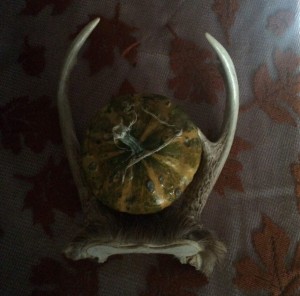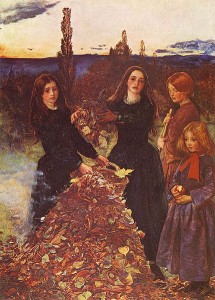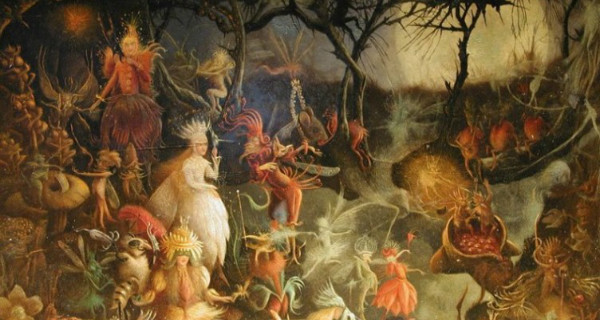Samhain Past: History, Myth, & Mystery
October 16, 2014 by 10 Comments
 Over the last three years I’ve written a lot about holidays and the traditions we associate with them. I’ve written extensively about Yuletide and and far more extensively than I ever would have dreamed about Ostara, Easter, and Imbolc. I’ve also posted a lot of stuff about Halloween in that time (here’s a complete history and here’s somebackground on individual thingsassociated with the holiday) but not a whole lot about Samhain.
Over the last three years I’ve written a lot about holidays and the traditions we associate with them. I’ve written extensively about Yuletide and and far more extensively than I ever would have dreamed about Ostara, Easter, and Imbolc. I’ve also posted a lot of stuff about Halloween in that time (here’s a complete history and here’s somebackground on individual thingsassociated with the holiday) but not a whole lot about Samhain.
Sure there are two Samhain Rituals on this blog and a few other odds and ends, but writing about the history of Samhain is difficult. Most of that is because we know very little about the history of the holiday. In some ways it exists in a pre-history sort of space. The folks who celebrated Samhain as pagans didn’t leave any writings detailing their holiday. By the time it was being written about, Ireland had effectively been Christianized.
There’s a second difficulty when it comes to writing about Samhain, many Modern Pagans have attached certain romantical notions to it. I recently wrote a piece on The Origins of Halloween Things and while no one criticized (or even really commented) on it here, I did read a few comments online. One of those made note of how ancient Celts dressed up to scare away ghosts and the like, with that being the origin point for Halloween dress-up. I’ve never read anything scholarly suggesting such a thing, but it’s an old story I’ve heard before, and I (most importantly) understand the appeal of it.
 In many ways Samhain (and by extension Halloween) is our holiday. Even though many Halloween trappings have their origins in Christian belief, Christians sometimes run away from them. For every Jack-o’-lantern thrown out by someone in Pat Robertson’s flock there have been two Pagans waiting there to pick it up. So much of Halloween feels Pagan that attempts to connect those things to an ancient Samhain simply feel right. Writing something that might hurt those beliefs makes me feel like the Grinch at Halloween. Also, either by coincidence or fate, the rise of the modern Halloween celebration has coincided with the rise of Modern Paganism, no wonder we feel so close to it.
In many ways Samhain (and by extension Halloween) is our holiday. Even though many Halloween trappings have their origins in Christian belief, Christians sometimes run away from them. For every Jack-o’-lantern thrown out by someone in Pat Robertson’s flock there have been two Pagans waiting there to pick it up. So much of Halloween feels Pagan that attempts to connect those things to an ancient Samhain simply feel right. Writing something that might hurt those beliefs makes me feel like the Grinch at Halloween. Also, either by coincidence or fate, the rise of the modern Halloween celebration has coincided with the rise of Modern Paganism, no wonder we feel so close to it.
Most Pagans who celebrate Samhain often refer to it as a Celtic holiday, but more accurately it’s an Irish one. The Irish who celebrated Samhain were most likely “Celtic,” but listing Samhain as a Celtic holiday implies a universality within Celtic culture that didn’t quite exist. There’s no evidence linking the Celts of ancient Gaul with a holiday called Samhain, nor those of Scotland. The Celtic people of Wales celebrated the 31st of October as Calan Gaeaf (the first day of Winter) but attached no special significance to it. This can all be explained away by saying “it was there, it’s just that no one wrote about,” which is quite possible, especially in the case of Gaul where most of what was written about the Celts came from Greco-Roman quills. (1)
Samhain is often thought to translate as “Summer’s end” but there’s no clear consensus on whether or not that’s actually the case. In the Tenth-Century Tochmarc Emire the story’s heroine (Emer) mentions Samhain as the time “when the summer goes to its rest.” Even if Samhain does not directly translate as “Summer’s end” it’s possible that it was thought of in such a way. (2)
Medieval Irish literature is full of references to Samhain (which includes the evening of October 31 and all of November 1), but most of those references are more mythological than historical. In The Pagan Religions of the British Isles Ronald Hutton describes the (literary) goings on of the day thusly:
“Tribal assemblies were held then, rulers and warriors conferred and laws were made. It was also the time at which humans were more susceptible to divine and supernatural interference. At Samhain heroic and royal figures met fated deaths or enchantments. Spirits, monsters, or fairies attacked royal capitals, with physical destruction or evil spells. Divine women allowed themselves to be wooed by human males. Supernatural beings fought or mated with each other, while warriors, gathered in royal halls, made important boasts or challenges. Magical gifts were presented to kings, or things stolen magically from them. (3)”
Myths often contain truths in the form of a story, and that’s most likely the case with Irish tales featuring Samhain. Perhaps it was the time of year when rulers and warriors met to discuss political matters. While it’s doubtful that there were a whole lot of fairies attacking royal capitals, the heavy sense of fear and the threat of the supernatural were most likely associated with the holiday as well. That Samhain was an especially busy night for malevolent forces might be the only custom we can set on Samhain’s doorstep with complete confidence.
If Halloween traditions contain an echo of ancient Samhains past then it’s possible that fire played a role in the celebration. The first documented mention of ahallowmas fire dates back to the relatively late date of 1589. However rites involving fire were common throughout the British Isles near Halloween, though far from universal. May-Day fires were a much more common occurrence, but Halloween fires are easily found in the historical record. Halloween (like Samhain before) was a time to fear supernatural forces. What better way to keep those forces at bay than a large bonfire? Fire is another aspect of Samhain that can’t be proven conclusively, but seems likely. (4)
While it’s unlikely that England’s Anglo-Saxons had an equivalent to Samhain on their calendar, the idea can’t be dismissed completely. The English historian Bede (writhingwriting* in the Eighth Century) calls October Vuinter-fylleth (the first month of Winter) and November Blod-monath (which translates as “Blood Month”). Blood Month most likely refers to the culling of the herds, but Bede also refers to the process as a sacrifice to the gods. The Celts of Ireland also culled their herds in early Winter, but Bede’s mention of it in Anglo-Saxon England has played a roll in linking the practice to Samhain. (5)
So far there are two major motifs missing in our search for what really transpired at Samhain two thousand years ago. The first of those is the presumed aspect of of Samhain serving as a type of harvest festival. If Samhain served as an opportunity for warriors and other important figures of society to get together it’s likely that there would have been some feasting involved. Who doesn’t feast when gathered with a few hundred friends? But the problem here is that the feast can only be inferred. A large bonfire might provide another opportunity for a hearty meal, but again it’s only conjecture. There’s nothing linking Samhain to harvest festival other than the pure likelihood of it. If later Halloween traditions are connected to Samhain the idea is even more tenuous. Halloween has rarely been a time for feasting, though it has often be dressed in the clothes of the harvest. (As are most holidays, humans tend to decorate with what’s available. Yuletide uses natural trappings too, but no one would ever argue that it’s a harvest festival.)
The second missing piece is the dead. When I hear the word Samhain I almost expect it to be followed by “the veil between the worlds is thin.” Samhain is simply something we associate the dead, and we assume it has always been so, right? This is another one of those hazy opportunities to say “maybe.” Samhain as the Celtic “feast of the dead” was first suggested by Sir James Frazier (author of the Golden Bough and a heavy influence on Modern Paganism) and the idea has been a popular one ever since. Frazier’s suggestion comes from Samhain’s proximity to the Christian holidays of All Saint’s and All Soul’s Days. (6) It’s always been popular to think of Christian holidays as thinly veiled pagan ones, and sometimes there’s a lot of truth to the idea, other times not so much.
The problem here is that All Saint’s and All Soul’s were established several centuries after Ireland’s conversion to Christianity. In addition both Saints and Souls were originally celebrated in May and then were later moved to November. Ireland had celebrated All Soul’s in May for several centuries and only moved the date when the Catholic Church did so in 1006. Samhain to All Soul’s is not a straight line, it’s a line with a missing piece. However with Samhain’s strong connection to unseen forces it’s not out of the realm of possibility to believe that ghosts and spirits played some role in the original holiday.
Ronald Hutton comments on what little we know of ancient Samhain in The Stations of the Sun. He writes:
“Thus, there seems to be no doubt that the opening of November was the time of a major pagan festival which was celebrated, at the very least, in all those parts of the British Isles with a pastoral economy. At most, it may have been general among the ‘Celtic’ peoples. There is no evidence that it was connected with the dead, and no proof that it opened the year, but it was certainly a time when supernatural forces were especially to be guarded or propitiated; actives which took different forms in different regions.” (7)
I think Hutton’s remarks nicely summarize what little we know about Samhain and just how much we don’t. However there’s one things missing from his remarks: the power late October/early November have over our collective psyches. There’s something spooky and marvelous about Samhain-time, something that was expressed by the Celts and by more modern peoples afterwards. Christians moved holidays to lay witness to the magick and mystery of late Autumn. Fear, coupled with the possibility of supernatural intervention, has remained a part of the holiday since its beginning and is still being celebrated today. The Irish-Celts may not have believed the “veil was thin” at Samhain, but they obviously believed that some sort of border between human and the other lifted in the Fall. There’s an irrepressible spirit in the air this time of year. It lived with our pagan forbearers and lives within us.
Happy Samhain!
Notes:
1. The Pagan Religions of the Ancient British Isles: Their Nature and Legacy by Ronald Hutton. Blackwell Publishers, 1991. page 176
2. Halloween: From Pagan Ritual to Party Night by Nicholas Rogers. Oxford University Press, 2002. page 11.
3. Isles, Hutton page 177.
4. The Stations of the Sun: A History of the Ritual Year in Britain by Ronald Hutton. Oxford University Press, 1996. page 363.
5. Stations, Hutton page 364.
6. Stations, Hutton page 363.
7. Stations, Hutton pages 369-370.
1. The Pagan Religions of the Ancient British Isles: Their Nature and Legacy by Ronald Hutton. Blackwell Publishers, 1991. page 176
2. Halloween: From Pagan Ritual to Party Night by Nicholas Rogers. Oxford University Press, 2002. page 11.
3. Isles, Hutton page 177.
4. The Stations of the Sun: A History of the Ritual Year in Britain by Ronald Hutton. Oxford University Press, 1996. page 363.
5. Stations, Hutton page 364.
6. Stations, Hutton page 363.
7. Stations, Hutton pages 369-370.
*What an absolutely wonderful typo.


No comments:
Post a Comment